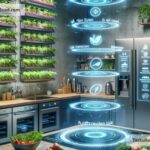The Future of Food and How Changing Populations Will Shape It
The way we grow, distribute, and eat food is changing quickly. In the coming decades, the future of food will be shaped by technology, climate change, and the way our world’s population grows and shifts. As more people are born and move to cities, we’ll need smarter ways to feed everyone while protecting the planet. Let’s explore how demographic shifts will affect what’s on our plates and how food innovation could solve these challenges.
The Growing World Population
Today, there are over 8 billion people on Earth, and the number is expected to rise. Experts predict that by 2050, we’ll have close to 10 billion people. This growing population will need more food than we produce today. At the same time, population growth isn’t happening equally everywhere. For example, many regions in Africa and Asia are experiencing faster growth, while some countries, like Japan and Germany, are seeing slower growth or even population decline.
With millions more mouths to feed in certain parts of the world, agriculture must adapt quickly. These shifts could increase the pressure on farmers to grow more crops and raise more animals, but they can’t do it the same way they’ve been doing for decades. Today’s farming techniques often use up too much water, harm the soil, and depend on harmful chemicals. To feed billions of people sustainably, we must think differently.
Urbanization: More People Living in Cities
Another major demographic change is urbanization. More people than ever are leaving rural areas and moving to cities. By 2050, about 70% of the world’s population will live in urban areas. Life in cities is different from life in farming communities, and this will create new demands for food that is fast, convenient, affordable, and healthy.
Urbanization will lead to changes in how food is grown and delivered. For example, we’re already seeing the rise of urban farms, where crops are grown indoors or on rooftops in cities. Vertical farming—where plants grow in stacked layers using LED lights instead of sunlight—could become more common. These farms take up less space and use fewer resources, making them a good option for feeding city populations.
Transportation and supply chains will also need to improve to get food to busy cities. Foods grown in one part of the world—like bananas from Ecuador or rice from India—end up traveling thousands of miles before reaching grocery stores. Making these systems faster, smarter, and more eco-friendly will be key as urban populations grow.
How Will Aging Populations Affect Food?
In many developed countries, people are living longer, and birth rates are falling. This means that the population is getting older. Aging populations will create new trends in food, especially when it comes to health. Older people often need diets that protect against heart disease, diabetes, and other health problems. Food companies are already starting to create products tailored to seniors, like fortified cereals, low-sodium soups, and protein-packed snacks.
In other parts of the world, younger populations will drive food trends. Millennials and Gen Z, for example, are known for being mindful about what they eat. They are more likely to choose plant-based foods, eat less meat, and care about sustainability. These preferences will push companies to create healthier, greener options that appeal to younger generations.
Technology Will Shape the Future of Food
Luckily, technology is stepping in to address many of these food challenges. Scientists and farmers are working together to come up with innovations that could change the way food is grown, processed, and delivered.
One exciting area is lab-grown meat, also called cultivated meat. Instead of raising animals for food, scientists grow meat directly from animal cells, meaning no farms or slaughterhouses are involved. This method uses fewer resources and causes less harm to the environment. By 2050, lab-grown meat might be a regular part of our diet.
Another food trend is alternative proteins. Plant-based burgers made from soy, peas, or mushrooms are already popular. Protein from insects is also gaining attention as a sustainable way to meet the world’s food needs. These options could help reduce the environmental impact of raising livestock while providing plenty of nutrients.
Farmers are also using technology to make agriculture smarter. Drones, sensors, and AI (artificial intelligence) help farmers monitor their fields and animals more efficiently. Robots can harvest crops, while apps can predict when plants will grow best. These tools save time and reduce waste, ensuring that we can grow enough food for everyone.
Climate Change and the Food Crisis
The future of food is not just about demographics—it’s also tied to the environment. Rising global temperatures, extreme weather, and changing rainfall patterns are already affecting crops. For example, droughts can destroy entire harvests, while floods can ruin farmland. To adapt, farmers will need to grow crops that are resistant to these changes, like drought-tolerant grains or heat-resistant vegetables.
Innovative solutions like aquaponics, hydroponics, and regenerative farming could become more popular. These farming methods use less water and improve soil health, making them more sustainable in a warming world.
Conclusion: Thinking Ahead About Food
The future of food will depend on how we plan for demographic changes and protect the planet. With more people living in cities, shifting age groups, and a growing population overall, the demand for sustainable food systems is urgent. Technology, smarter farming, and innovative products like lab-grown meat are likely to play major roles.
As individuals, we also have the power to shape the food industry. By choosing sustainable, healthy options, we can push companies and farmers to do better. The world’s food system is changing—and we all have a part in deciding what’s next.


